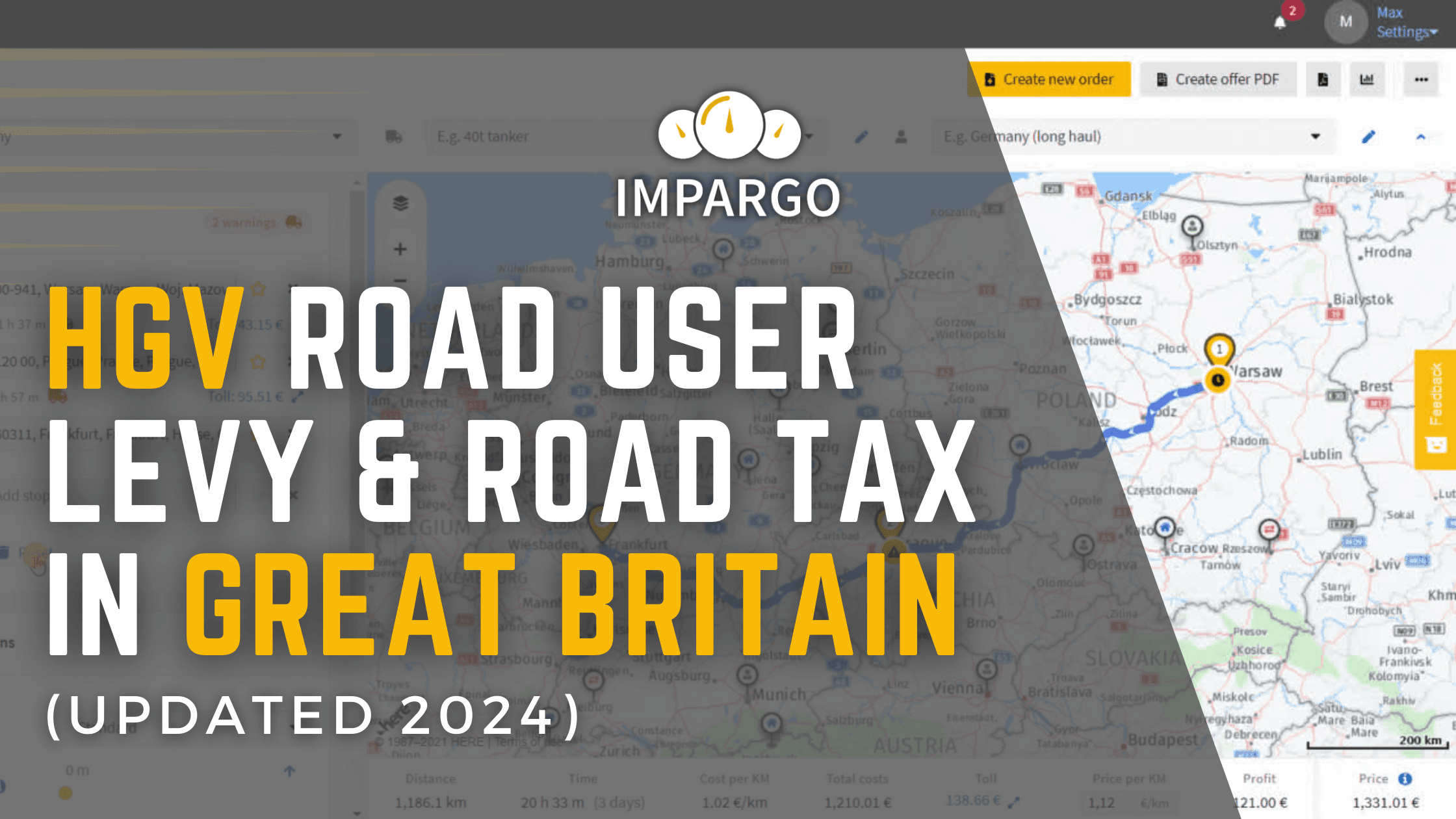
Introduction:
The HGV Road User Levy and road tax regulations in Great Britain are essential for ensuring that heavy goods vehicles (HGVs) contribute to the maintenance and upkeep of the road network.
In this article, we will provide a comprehensive guide for HGV operators in the road freight transport industry, covering topics such as levy rates, proposed rate increases, road tolls, CO2 emission surcharges, Low Emission Zones (LEZs), and future road pricing and user charging schemes.
Table of Contents:
- HGV Road User Levy Rates for 2023
- Proposed Rate Increases for 2024
- Road Tolls for HGVs
- How to Calculate Toll Costs in GB and Europe
- Factors Affecting the Levy Amount
a. Vehicle Weight
b. Vehicle Air Quality Emissions Standard
c. Levy Duration - CO2 Emission Surcharge and Road Tax
- Expansion of Low Emission Zones (LEZs)
- Localized Tolls and Cost Considerations
- Reintroduction of the HGV Road User Levy and Vehicle Tax
- Future Road Pricing and User Charging Schemes
HGV Road User Levy Rates for 2023:
The HGV Road User Levy rates are determined based on the vehicle's weight. Rates differ for newer vehicles (Euro 6 class or later) and older vehicles (Euro 5 class or older). The levy is charged on a daily, weekly, monthly, or yearly basis, with rates varying accordingly.
As for the HGV road user levy rates by levy band, the rates are as follows:
HGV levy rates for newer vehicles – Euro 6 class or later.
(Levy amount for levies purchased August 2023 onward)
HGV levy band | Weight (kg) | Daily rate | Weekly rate | Monthly rate | Yearly rate |
A | 12,000 to 31,000 | £3 (3.47 EUR) | £7.50 (8.68 EUR) | £15 (17.36 EUR) | £150 (173.63 EUR) |
B | 31,001 to 38,000 | £7.20 (8.33 EUR) | £18 (20.84 EUR) | £36 (41.67 EUR) | £360 (416.70 EUR) |
C | 38,001 and over | £9 (10.42 EUR) | £28.80 (33.34 EUR) | £57.60 (66.67 EUR) | £576 (666.72 EUR) |
HGV levy rates for older vehicles – Euro 5 class or older.
HGV levy band | Weight (kg) | Daily rate | Weekly rate | Monthly rate | Yearly rate |
A | 12,000 to 31,000 | £3.90 (4.51 EUR) | £9.75 (11.29 EUR) | £19.50 (22.57 EUR) | £195 (225.71 EUR) |
B | 31,001 to 38,000 | £9.36 (10.83 EUR) | £23.40 (27.09 EUR) | £46.80 (54.17 EUR) | £468 (541.71 EUR) |
C | 38,001 and over | £10 (11.58 EUR) | £37.45 (43.35 EUR) | £74.90 (86.70 EUR) | £749 (866.97 EUR) |
Disclaimer: the information provided in these tables is not binding. For official and authoritative information, please click here.
Proposed Rate Increases for 2024
The Department for Transport (DfT) has proposed rate increases for the HGV Road User Levy and road tax in 2024.
The increases range from 2-4% depending on the vehicle weight band. A final decision on the 2024 rates is expected later this year.
Road Tolls for HGVs in UK and GB
In general, road tolls in the UK do not apply to HGVs, except for specific bridges and tunnels. The Dartford Crossing between Kent and Essex charges a toll of £2.50 for HGVs. Some bridges in Scotland also have tolls for HGVs.
HGV operators need to consider these tolls when planning their routes and accounting for costs
As for HGV trucks that are not required to pay the Levy:
If the vehicle is not equipped with trade plates, it is required to pay the levy.
Vehicles that have zero tailpipe emissions and would normally be exempt from vehicle excise duty (VED) are currently exempt from paying the levy. This exemption does not apply to hybrid vehicles.
Non-UK HGVs must carry documentation to prove that their vehicle has zero tailpipe emissions.
The following vehicles are also exempt from the levy:
- Vehicles used for driver instruction
- Showman's vehicles
- Island goods vehicles used exclusively on small islands and not on mainland UK roads.
You also do not need to pay the levy if, in a whole 24-hour period, if you:
- only drive on minor roads
- are parked up
A minor road is a road that starts with a B or has no road number.
You have to pay the levy if you use a main road at any point in the 24-hour period.
If you stay in the UK longer than planned and your levy expires, you must pay for the additional days.
How to Calculate Toll Costs in GB and Europe
HGV operators can further optimize their toll costs by utilizing innovative solutions such as IMPARGO.
With the IMPARGO truck toll calculator for Europe, operators can calculate tolls on all European roads and highways, including tunnels and bridges. This tool provides up-to-date toll information and allows for toll-optimized routing, helping reduce toll expenses.
Furthermore, IMPARGO users can gain a detailed overview of tolled and untolled kilometers by country, as well as by service provider, such as Toll Collect, ASFiNAG, ViaPass, APRR, and AREA.
This comprehensive approach to toll management empowers HGV operators to make informed decisions and minimize their toll costs effectively.
Factors Affecting the Levy Amount
The amount of the HGV Road User Levy is determined based on the following factors:
1. Vehicle Weight: Heavier vehicles generally emit more CO2, and therefore, a higher levy amount is applied to them. The levy takes into account the weight of the vehicle, which serves as a broad approximation of its CO2 emissions.
2. Vehicle Air Quality Emissions Standard: The EURO emissions class of the vehicle is considered in determining the levy amount. Vehicles with higher EURO emissions classes typically have lower emissions and may be subject to a lower levy amount.
3. Levy Duration: The duration for which the levy is paid also affects the amount. The levy is charged on a daily, weekly, monthly, or annual basis. The longer the duration, the higher the total levy amount.
You have to pay the levy for any day that you drive an HGV that weighs 12,000kg or more on a main road in the UK. That includes main roads in England, Northern Ireland, Scotland and Wales.
A main road is a road that starts with an ‘A’ or an ‘M’, for example, the A2 or the M20. Almost all the roads from UK ports are main roads.
CO2 Emission Surcharge and Road Tax
HGVs registered in the UK may be subject to a CO2 emission surcharge as part of the HGV Road User Levy and road tax obligations. The surcharge amount varies based on the vehicle's CO2 emissions and ranges from £15 to £1,000. It is important for HGV operators to factor in these surcharges when calculating road tax responsibilities.
Expansion of Low Emission Zones (LEZs)
Low Emission Zones (LEZs) are being expanded to more cities in the UK. These zones charge additional fees for vehicles that do not meet certain emissions standards, including HGVs.
The expanded Birmingham LEZ, for instance, will begin charging fees to non-compliant HGVs in 2023. HGV operators should ensure their vehicles meet the required Euro class standards to avoid additional charges and comply with the road tax regulations.
Localized Tolls and Cost Considerations
Certain major bridges and tunnels in the UK charge tolls specifically for HGVs.
For example, the Mersey Gateway Bridge charges £10 for HGVs, and the Tyne Tunnel charges £2 for HGVs.
It is important for HGV operators to consider these localized tolls when planning their routes and factoring in their road tax obligations.
Reintroduction of the HGV Road User Levy and Vehicle Tax
After being suspended in 2020, the HGV Road User Levy and vehicle tax were reintroduced in Great Britain on 1 August 2023.
The reformed levy takes into account the vehicle's weight and EURO emissions class, with rates varying accordingly. The vehicle tax component ensures that HGVs comply with their tax obligations.
Future Road Pricing and User Charging Schemes
The UK government is exploring additional road pricing and user charging schemes, including potential changes to the road tax system. This may include per-mile charging on major roads in the future. However, as of now, no new nationwide programs have been implemented.
HGV operators should stay informed about any future developments in road pricing and user charging schemes to adapt their road tax planning accordingly.
Conclusion
The HGV Road User Levy and road tax regulations in Great Britain play a significant role in ensuring that heavy goods vehicles contribute to the maintenance and upkeep of the road network. The levy amount is determined based on factors such as vehicle weight, Euro class emissions standards, and levy duration. The reintroduction of the HGV Road User Levy and vehicle tax in 2023 has reinstated the obligations for HGV operators. CO2 emission surcharges, road tolls, localized tolls, and the expansion of Low Emission Zones (LEZs) further impact road tax considerations for HGVs. HGV operators should stay updated on proposed rate increases and future road pricing and user charging schemes to comply with the regulations and optimize their road tax planning in the road freight transportation industry.

